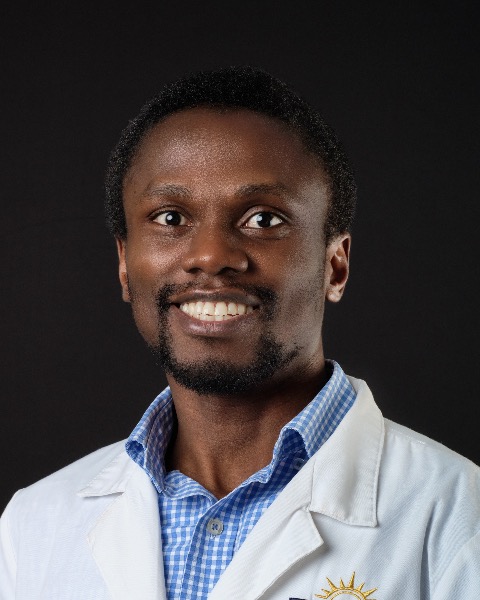Tuesday Poster Session
Category: Functional Bowel Disease
P5107 - Repetitive Translumbosacral Neuromodulation Therapy (TNT) for Severe Neuropathy After Spinal Cord Surgery
Tuesday, October 28, 2025
10:30 AM - 4:00 PM PDT
Location: Exhibit Hall

Kwabena Asafo-Agyei, MD
Medical College of Georgia at Augusta University
Evans, GA
Presenting Author(s)
Kwabena Asafo-Agyei, MD1, Navkiran Randhawa, DO2, Phuong Nguyen, MD2, Karlo Fidel, MD3, Satish SC. Rao, MD, PhD, FACG3
1Medical College of Georgia at Augusta University, Evans, GA; 2Medical College of Georgia at Augusta University, Augusta, GA; 3Augusta University Medical Center, Augusta, GA
Introduction: A significant number of patients with dyssynergic defecation syndrome demonstrated lumbar plexus or sacral plexus neuropathy or both. A number of treatment modalities have been used to treat dyssynergic defecation. However, a novel treatment using Translumbosacral Neuromodulation Therapy (TNT), which involves repetitive pulses of magnetic energy to stimulate the lumbar and sacral plexus. However, this new therapy offers an improvement in patients with lumbar and sacral neuropathies.
Case Description/
Methods: A 74-year-old with a history of spinal stenosis who underwent revision L2-pelvis fusion with L3-5 decompression on 11/20/2023. He had normal bowel function preceding the procedure and developed severe constipation with fecal impaction after the procedure, requiring multiple hospitalizations despite multiple laxatives. The patient also had worsening back pain, foot weakness, severe radiculopathy, urinary retention, and orthostatic hypotension. He underwent revision on 04/9/2024 with no improvement in symptoms. Despite treatment with multiple laxatives, the patient progressively worsened and required a colostomy on 08/20/2024, and was referred to our facility. The patient received multiple therapies, including biofeedback and TNT sessions for dyssynergic defecation and severe lumbosacral neuropathy. Before treatment, the modified Oswestry low back pain disability questionnaire was 42%, and after treatment, it was 32%. Additionally, urinary retention resolved after two sessions of TNT, and Translumbosacral Anorectal Magnetic Stimulation (TAMS) showed severe lumbosacral neuropathy before treatment and normal after the last session. Balloon expulsion time improved from 55s to 12s. Moreover, the patient has been able to cut down on multiple laxatives and is now on Miralax 2 cups/day and scheduled for reversal of colostomy in the coming weeks.
Discussion: TNT has shown benefit not only as a diagnostic tool for identifying lumbosacral parasympathetic and sympathetic neuropathies but also as a treatment modality as shown in our patient who is currently scheduled for reversal of colostomy.
This treatment modality has a very good device tolerability. Translumbosacral neuromodulation therapy (TNT) utilizes repetitive pulses of magnetic energy to stimulate the lumbar and sacral plexus nerves, aiming to promote nerve regeneration and plasticity. It is therefore imperative for gastroenterologists to be aware of this safe diagnostic and treatment modality, thereby enabling better patient outcomes.
Disclosures:
Kwabena Asafo-Agyei indicated no relevant financial relationships.
Navkiran Randhawa indicated no relevant financial relationships.
Phuong Nguyen indicated no relevant financial relationships.
Karlo Fidel indicated no relevant financial relationships.
Satish Rao: Laborie Medical Technologies – Grant/Research Support. Vibrant Ltd – Advisory Committee/Board Member.
Kwabena Asafo-Agyei, MD1, Navkiran Randhawa, DO2, Phuong Nguyen, MD2, Karlo Fidel, MD3, Satish SC. Rao, MD, PhD, FACG3. P5107 - Repetitive Translumbosacral Neuromodulation Therapy (TNT) for Severe Neuropathy After Spinal Cord Surgery, ACG 2025 Annual Scientific Meeting Abstracts. Phoenix, AZ: American College of Gastroenterology.
1Medical College of Georgia at Augusta University, Evans, GA; 2Medical College of Georgia at Augusta University, Augusta, GA; 3Augusta University Medical Center, Augusta, GA
Introduction: A significant number of patients with dyssynergic defecation syndrome demonstrated lumbar plexus or sacral plexus neuropathy or both. A number of treatment modalities have been used to treat dyssynergic defecation. However, a novel treatment using Translumbosacral Neuromodulation Therapy (TNT), which involves repetitive pulses of magnetic energy to stimulate the lumbar and sacral plexus. However, this new therapy offers an improvement in patients with lumbar and sacral neuropathies.
Case Description/
Methods: A 74-year-old with a history of spinal stenosis who underwent revision L2-pelvis fusion with L3-5 decompression on 11/20/2023. He had normal bowel function preceding the procedure and developed severe constipation with fecal impaction after the procedure, requiring multiple hospitalizations despite multiple laxatives. The patient also had worsening back pain, foot weakness, severe radiculopathy, urinary retention, and orthostatic hypotension. He underwent revision on 04/9/2024 with no improvement in symptoms. Despite treatment with multiple laxatives, the patient progressively worsened and required a colostomy on 08/20/2024, and was referred to our facility. The patient received multiple therapies, including biofeedback and TNT sessions for dyssynergic defecation and severe lumbosacral neuropathy. Before treatment, the modified Oswestry low back pain disability questionnaire was 42%, and after treatment, it was 32%. Additionally, urinary retention resolved after two sessions of TNT, and Translumbosacral Anorectal Magnetic Stimulation (TAMS) showed severe lumbosacral neuropathy before treatment and normal after the last session. Balloon expulsion time improved from 55s to 12s. Moreover, the patient has been able to cut down on multiple laxatives and is now on Miralax 2 cups/day and scheduled for reversal of colostomy in the coming weeks.
Discussion: TNT has shown benefit not only as a diagnostic tool for identifying lumbosacral parasympathetic and sympathetic neuropathies but also as a treatment modality as shown in our patient who is currently scheduled for reversal of colostomy.
This treatment modality has a very good device tolerability. Translumbosacral neuromodulation therapy (TNT) utilizes repetitive pulses of magnetic energy to stimulate the lumbar and sacral plexus nerves, aiming to promote nerve regeneration and plasticity. It is therefore imperative for gastroenterologists to be aware of this safe diagnostic and treatment modality, thereby enabling better patient outcomes.
Disclosures:
Kwabena Asafo-Agyei indicated no relevant financial relationships.
Navkiran Randhawa indicated no relevant financial relationships.
Phuong Nguyen indicated no relevant financial relationships.
Karlo Fidel indicated no relevant financial relationships.
Satish Rao: Laborie Medical Technologies – Grant/Research Support. Vibrant Ltd – Advisory Committee/Board Member.
Kwabena Asafo-Agyei, MD1, Navkiran Randhawa, DO2, Phuong Nguyen, MD2, Karlo Fidel, MD3, Satish SC. Rao, MD, PhD, FACG3. P5107 - Repetitive Translumbosacral Neuromodulation Therapy (TNT) for Severe Neuropathy After Spinal Cord Surgery, ACG 2025 Annual Scientific Meeting Abstracts. Phoenix, AZ: American College of Gastroenterology.
